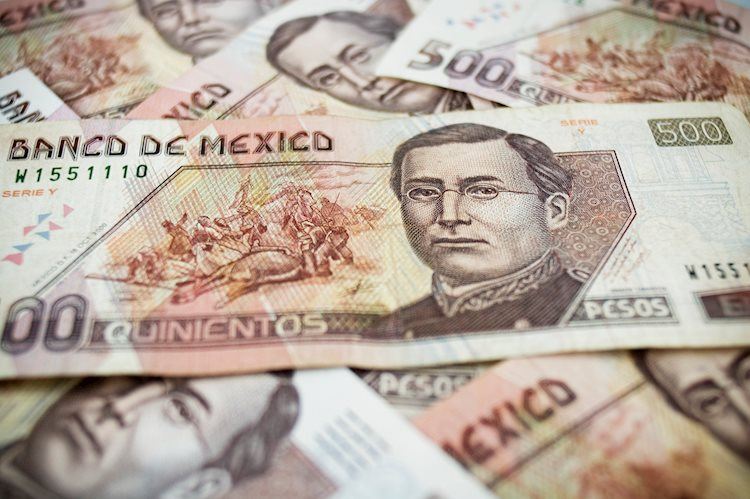
- Mexican Peso halts two-day losing streak against USD, with USD/MXN trading down on the day.
- Banxico minutes reveal a unanimous decision to maintain rates, highlighting ongoing challenges in Mexico’s disinflation process.
- USD/MXN to remain trading range-bound amid low volume due to the Thanksgiving holiday in the US.
Mexican Peso (MXN) snaps two days of losses against the US Dollar (USD), though it remains sideways amid thin liquidity trading as markets remain closed in observance of the Thanksgiving holiday in the United States (US). The latest Bank of Mexico (Banxico) minutes emphasized the need to maintain rates higher for “some time” to bring inflation to its target. That, along with the improvement in inflation revealed early on Thursday, weighs on the USD/MXN, which remains trading with losses of 0.02%.
Banxico minutes showed that the Government Board voted unanimously to hold rates at 11.25% for the fifth consecutive meeting after a two-year rate-hike cycle. Policymakers acknowledged advances in the disinflation process, though they emphasized the outlook remained “challenging.”
An earlier report showed that inflation data was mixed, with Mexico’s inflation witnessing an uptick in headline mid-November inflation in monthly and annually based figures. At the same time, the core CPI, which excludes volatile items, was below estimates and the prior reading. The rise in inflation could be attributed to the government’s end of the power summer subsidies in some cities.
Daily digest movers: Mexican Peso virtually unchanged due to the US holiday
- The Mexican Consumer Price Index (CPI) for mid-November annually increased by 4.32%, exceeding estimates of 4.31%.
- Core CPI in Mexico decelerated compared to previous data and slowed to 5.31%, below forecasts of 5.33%.
- INEGI estimates the economy shrank 0.1% MoM in October, though annually based, it expanded by 2.9%, according to the agency Timely Indicator of Economic Activity (IOAE).
- A Citibanamex poll suggests that 25 of 32 economists polled expect Banxico’s first rate cut in the first half of 2024.
- The poll shows “a great dispersion” for interest rates next year, between 8.0% and 10.25%, revealed Citibanamex.
- The same survey revealed that economists foresee headline annual inflation at 4% and core at 4.06%, both readings for the next year, while the USD/MXN exchange rate is seen at 19.00, up from 18.95, toward the end of 2024
- Data published last week showed prices paid by consumers and producers in the US dipped, increasing investors’ speculations that the Fed’s tightening cycle has ended.
- The swap market suggests traders expect 100 basis points of rate cuts by the Fed in 2024.
- Banxico revised its inflation projections from 3.50% to 3.87% for 2024, which remains above the central bank’s 3.00% target (plus or minus 1%).
Technical Analysis: Mexican Peso stays firm, though USD/MXN trades range-bound on thin liquidity conditions
The USD/MXN remains bearishly biased, as the pair remains trading well below the downward slope of the 100, 20, 200, and 50-day Simple Moving Averages (SMAs). Even though it formed a ‘tweezers bottom’ chart pattern, price action was capped below the November 21 high of 17.26, which so far weighed on the pair, which dipped to a two-day low of 17.14.
For a bearish continuation, the exotic pair must get toward the 17.00 figure, so sellers could threaten to drag prices toward the year-to-date (YTD) low of 16.62. On the other hand, if buyers reclaim the current week’s high of 17.26, that could open the door to testing the 100-day SMA.
Risk sentiment FAQs
In the world of financial jargon the two widely used terms “risk-on” and “risk off” refer to the level of risk that investors are willing to stomach during the period referenced. In a “risk-on” market, investors are optimistic about the future and more willing to buy risky assets. In a “risk-off” market investors start to ‘play it safe’ because they are worried about the future, and therefore buy less risky assets that are more certain of bringing a return, even if it is relatively modest.
Typically, during periods of “risk-on”, stock markets will rise, most commodities – except Gold – will also gain in value, since they benefit from a positive growth outlook. The currencies of nations that are heavy commodity exporters strengthen because of increased demand, and Cryptocurrencies rise. In a “risk-off” market, Bonds go up – especially major government Bonds – Gold shines, and safe-haven currencies such as the Japanese Yen, Swiss Franc and US Dollar all benefit.
The Australian Dollar (AUD), the Canadian Dollar (CAD), the New Zealand Dollar (NZD) and minor FX like the Ruble (RUB) and the South African Rand (ZAR), all tend to rise in markets that are “risk-on”. This is because the economies of these currencies are heavily reliant on commodity exports for growth, and commodities tend to rise in price during risk-on periods. This is because investors foresee greater demand for raw materials in the future due to heightened economic activity.
The major currencies that tend to rise during periods of “risk-off” are the US Dollar (USD), the Japanese Yen (JPY) and the Swiss Franc (CHF). The US Dollar, because it is the world’s reserve currency, and because in times of crisis investors buy US government debt, which is seen as safe because the largest economy in the world is unlikely to default. The Yen, from increased demand for Japanese government bonds, because a high proportion are held by domestic investors who are unlikely to dump them – even in a crisis. The Swiss Franc, because strict Swiss banking laws offer investors enhanced capital protection.
- SEO Powered Content & PR Distribution. Get Amplified Today.
- PlatoData.Network Vertical Generative Ai. Empower Yourself. Access Here.
- PlatoAiStream. Web3 Intelligence. Knowledge Amplified. Access Here.
- PlatoESG. Carbon, CleanTech, Energy, Environment, Solar, Waste Management. Access Here.
- PlatoHealth. Biotech and Clinical Trials Intelligence. Access Here.
- Source: https://www.fxstreet.com/news/mexican-peso-recovers-slightly-amid-us-holiday-traders-eye-banxicos-minutes-202311231530



